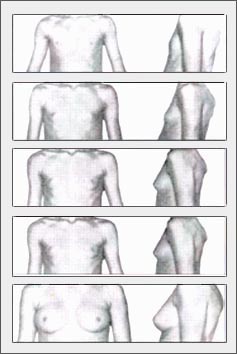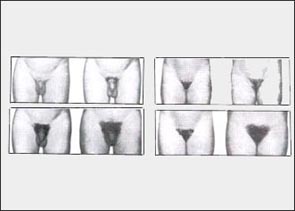사춘기 여아들의 2차 성징, Female adolescent secondary sex characteristics
- 사춘기가 오면 뇌하수체의 전 엽에서 성장호르몬이 왕성히 분비되고 성장억제 호르몬의 분비가 감소된다.
- 뇌하수체의 전 엽에서 황체형성 호르몬(LH)와 난포 자극 호르몬(FSH)이 분비되어 난소에서 에스트로겐과 프로게스테론이 분비된다.
- 이들 호르몬 이외 다른 여러 종류의 호르몬의 역할로 여아 사춘기의 이차성징이 나타난다.
- 여아들에게 사춘기가 오면 맨 처음 젖꼭지가 커지기 시작하고 젖꼭지의 주위에 있는 피부에 유두륜(유륜)이 생긴다.
- 유두륜에 융기(몽고메리 돌기)가 생기고, 유두륜과 젖꼭지의 색이 짙어진다. 그리고 에스트로겐과 프로게스테론 등의 영향을 받아 유방 속에 지방조직이 많이 축적되어 유방의 전체가 점점 커지기 시작한다.
- 이런 변화는 8~11세 여아들에게 시작되는 것이 보통이나 늦게는 14세에 시작되기도 한다.
- 대 음순이 살이 찌고 두꺼워지고 현저하게 커지고 소음순과 대 음순이 쉽게 분별될 수 있게 커진다.
- 음핵도 커진다.
- 음모가 처음에는 치구 부위에서 조금 나기 시작하다가 점차로 대 음순까지 퍼져 난다.
- 이 시기에 초경을 하는 것이 보통이다.
- 피부에 있는 피지선의 기능이 왕성해지고 겨드랑이와 보지에 있는 아포크린 선들이 발달되고 커지고 그 기능이 활발해지기 시작한다.
- 아포크린선에서 분비는 분비물에서 여성냄새가 난다.


Female adolescent secondary sex characteristics
• When puberty comes, growth hormone is secreted vigorously from the anterior lobe of the pituitary gland and the secretion of growth inhibitory hormone is decreased.
• Luteinizing hormone (LH) and follicle-stimulating hormone (FSH) are secreted from the anterior lobe of the pituitary gland, and estrogen and progesterone are secreted from the ovary.
• In addition to these hormones, the secondary sexual characteristics of puberty girls appear due to the role of several other hormones.
• When girls reach puberty, the first nipples start to grow and the areola (areola) forms on the skin around the nipple.
• A bump (Montgomery projection) is formed on the nipple ring, and the color of the nipple ring and nipple becomes dark. And under the influence of estrogen and progesterone, a lot of fat tissue accumulates in the breast, and the entire breast begins to grow larger.
• These changes usually begin in girls aged 8-11, but as late as age 14.
• The labia majora gain weight, thicken and noticeably enlarge and the labia minora and labia majora become easily distinguishable.
• The clitoris is also enlarged.
• The pubic hair begins to grow a little in the pubic area, and then gradually spreads to the labia majora.
• Menarche is common at this time.
• The function of the sebaceous glands in the skin becomes active, and the apocrine glands in the armpits and pussy develop and enlarge and their functions begin to become active.
• The secretions from the apocrine glands have a feminine odor. Figure 7-1 Breast development in adolescent girls. Source-Copyrightⓒ 2001 John Sangwon Lee, MD., FAAP


Figure 7-2, 7-3. Normal development of breasts in adolescent girls according to Tanner secondary sexual development stages (top photo) Normal development of external reproductive system in adolescent boys (left, right) and normal development in adolescent girls (lower body photo) Source – Encyclopedia of Pediatric Orthopedic Nursing – Parents should also be anti-conscientious. p 732-734 and Vaughan, V.C. McKay. R.J. and Behrman, R.E., Nelson Textbook of Pediatrics of Pediatrics, Philadelphia, W. B. Saunders Co. 1979 (used with permission)
• www.drlepdiatrics.com – Volume 3 The growth and development of newborns, infants, school-age and adolescent children. Volume 10 Kidney and Adolescent Kidney and Urogenital Diseases. See Volume 14 Children and Adolescents Endocrinology, Genetics, Chromosomes, Metabolism, and Rare Diseases
출처 및 참조 문헌 Sources and references
- NelsonTextbook of Pediatrics 22ND Ed
- The Harriet Lane Handbook 22ND Ed
- Growth and development of the children
- Red Book 32nd Ed 2021-2024
- Neonatal Resuscitation, American Academy of Pediatrics
-
The Johns Hopkins Hospital, The Harriet Lane Handbook, 22nd edition
-
Red book 31st edition 2021
-
Nelson Text Book of Pediatrics 21st Edition
-
Emergency Pediatrics A Guide to Ambulatory Care, Roger M. Barkin, Peter Rosen
-
Ambulatory Pediatrics, Green and Haggerty, Saunders
-
School Health: A Guide For Health Professionals, American Academy of Pediatrics
-
How to really love your child Ross Campbell
-
Good Behavior Stephen W. Garber, Ph.D. and other
-
Adolescent Medicine and The Media Adolescents Medicine
-
AM: Stars Adolescent Medicine: State of the Art Reviews, Asthma, and Diabetes in A
-
The Pediatric Clinics of North America, Adolescent Gynecology, Part II THe Sexually Active Adolescent, August 1999
-
Fueling the Teen Machine, Ellen Shanley and Colleen Thompson
-
Why Teenagers Act the Way They Do, Eight Adolescent Personality Types: Understanding and Dealing With Them, Dr. G. Keith Olson
-
The Pregnancy bible Joan Stone, Keith Eddleman
-
Pediatric and Adolescent Endocrinology, The Pediatric Clinics of North America in August 1987
-
Adolescent Gynecology, Ross Round table
-
Female Reproductive Health, Adolescent Medicine Patricia S. Simmons, M.D., Marc. Laufer, M.D.
-
The Adolescent Male: Adolescent Medicine, David S. Rosen, M.P.H., Michael Rich, M.D.
-
Lesbian and Gay Youth: Care And Counseling, Adolescent Medicine, Caitlin Ryan, M.S.W, A.C.S.W., Donna Futterman, M.D.
-
Medical and Gynecologic Endocrinology: Joseph S. Sanfilippo, M.D., Jordan W. Finkelstein, M.D., Dennis M. Styne. M.D., Adolescent Medicine Clinics, Oct. 2005 Vol. 16
-
Robert T. Brown, M.D., Paula K. Braverman, M.D.
-
진정한 자녀 사랑 나비게이터
-
10대 아들 딸 이렇게 사랑해 키워라 이상원 역
-
소아과학 대한교과서
-
의학 용어사전 대한 의사 협회
-
제24권 사춘기 성교육 출처 참조 문헌
- Gray Anatomy
- 제 25권 임신, 분만, 출산, 신생아 돌보기 이상원저
-
그 외
|
Copyright ⓒ 2015 John Sangwon Lee, MD., FAAP 미국 소아과 전문의, 한국 소아청소년과 전문의 이상원 저 “부모도 반의사가 되어야 한다”-내용은 여러분들의 의사로부터 얻은 정보와 진료를 대신할 수 없습니다. The information contained in this publication should not be used as a substitute for the medical care and advice of your doctor. There may be variations in treatment that your doctor may recommend based on individual facts and circumstances. “Parental education is the best medicine.” |